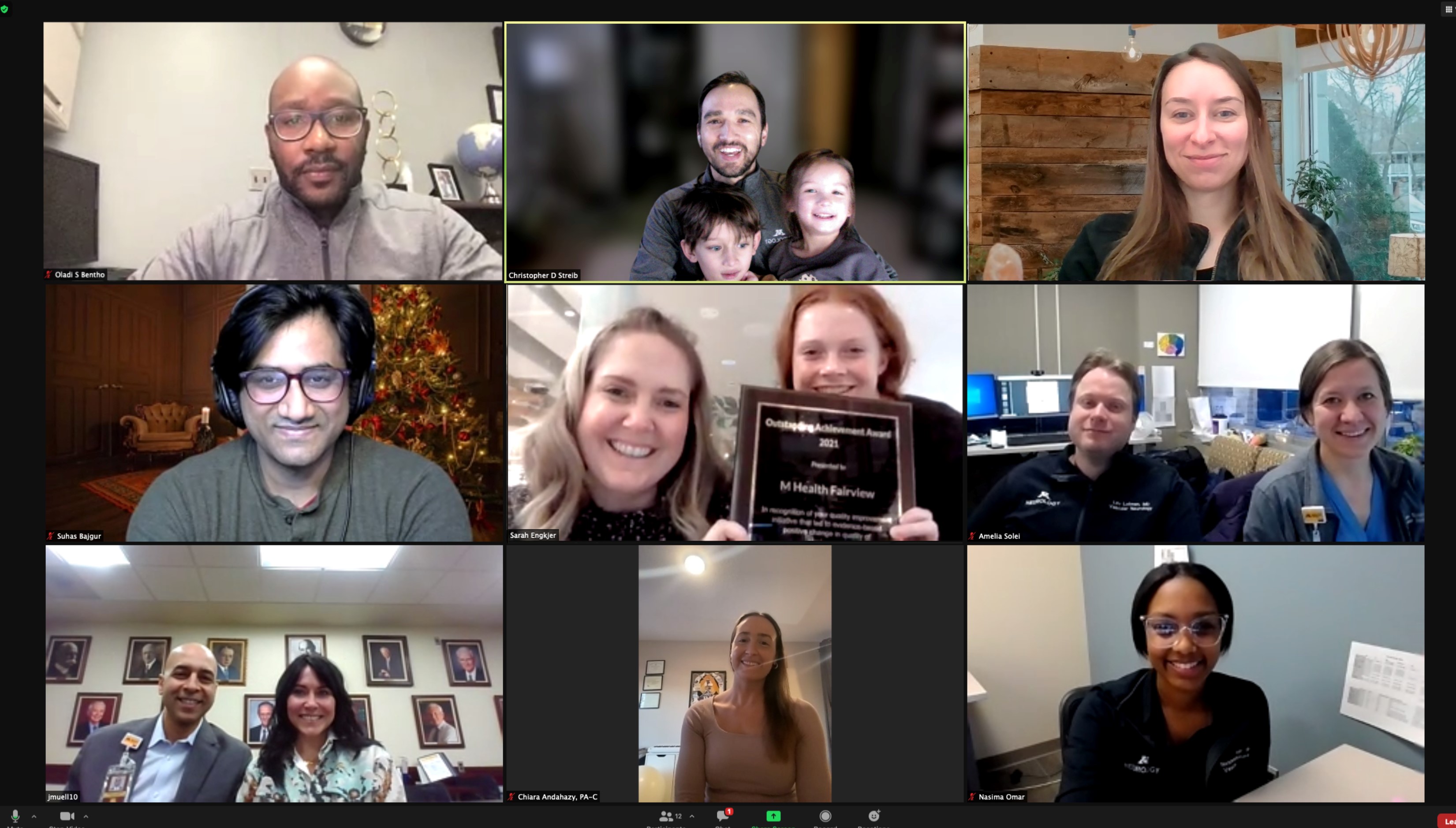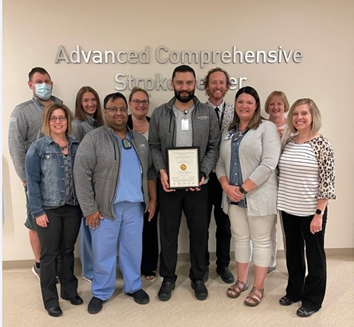Stroke Quality Improvement Awards 2021
The Minnesota Stroke System includes 13 Comprehensive Stroke Centers (CSC), 10 Primary Stroke Centers (PSC), and 92 Acute Stroke Ready Hospitals (ASRH). All hospitals part of the Minnesota Stroke System continually strive to improve quality of care for patients. This award program aims to recognize and showcase successful quality improvement initiatives throughout the state of Minnesota’s hospital-based stroke programs.
2021 Award Categories
Awards are given to hospital stroke programs in Minnesota that implemented the best quality improvement initiatives in the following categories:
- Continuous Impact: Award for starting an initiative that created a meaningful and long-term improvement in quality of stroke care.
- Operational Excellence: Award for initiative that focused on collaboration between different programs to improve quality of stroke care.
- Outstanding Achievement: Award for initiative that led to evidence-based positive change in quality of stroke care
2021 Continuous Impact Award Recipients
Award for starting an initiative that creates a meaningful and long-term improvement in quality of stroke care.
Essentia Health - St. Joseph’s Medical Center, Primary Stroke Center
Brainerd, Minnesota

- Opportunity for Improvement: Increase documentation of a patient’s pre-stroke level of function to assess post stroke recovery.
- Action Plan: Met with the multi-disciplinary stroke committee involved with the quality improvement plan and found that the Therapy Department should be accountable to perform and document the pre-stroke modified Rankin Scale (mRS). Updated documentation within the electronic health record and mRS education was reviewed. Staff practiced collecting mRS as well as documenting within the electronic health record.
- Results: Improved pre-stroke mRS documentation from Q3 2020 to Q1 2021. Remained consistent and/or improved in post-discharge mRS.
Award Qualifications
- Worked with multiple departments to identify who was responsible for new workflow to collect pre-stroke mRS.
- Excellent attention to detail helped uncover scores could vary by discipline.
Mercy Hospital, Primary Stroke Center
Coon Rapids, Minnesota

- Opportunity for Improvement: Decreasing the amount of time patients with stroke symptoms spend waiting for thrombolytic treatment upon arrival to the hospital. Goal was to treat at least 75% of cases within ≤60 minutes of admittance, and at least 50% of our cases would be treated within ≤45 minutes of admittance to the hospital.
- Action Plan: Implemented telestroke carts in CT suites and ED stabilization rooms for prompt examination of stroke patients so providers could create a treatment plan more quickly once CT results were in. Radiologists called the CT results directly to the stroke neurologist to facilitate faster treatment decisions. Stroke patients arriving by EMS were taken straight to imaging whenever possible. Stroke Program Committee reviewed every alteplase case weekly after implementation to refine and improve new processes.
- Results: Since implementation January 2021, Mercy Hospital has met and exceeded the goal. Compliance for cases ≤ 60 minutes is 78%, and compliance for cases ≤ 45 minutes is 62%. The time patients spend between coming through hospital doors to being treated has decreased by an average of 9 minutes.
Award Qualifications
- Strong results that will have continue to meaningful impact on quality stroke care.
- Multiple approaches to address goal.
- Demonstrated commitment across departments by overcoming challenges to meet goal.
Maple Grove Hospital, Acute Stroke Ready Hospital
Maple Grove, Minnesota

- Opportunity for Improvement: Increase documentation of stroke education provided to patients, and pre-stroke functionality assessment using the modified Rankin Scale (mRS) completed at discharge for admitted stroke patients.
- Action Plan: Delivered education to inpatient nursing staff on how to provide stroke education and how to fulfill the requirements of documentation. This was completed through mock codes, annual learning activities, team newsletters, Stroke Awareness Month boards, and presentations at multiple department meetings. Feedback emails were sent to nurses who discharged stroke patients detailing if all required documentation was completed.
- Results: Prior to the quality improvement project, no stroke education was provided and no mRS completed at discharge. Even with low count of admitted patients, the first quarter after implementation shows 83% compliance for stroke education and 50% compliance for mRS.
Award Qualifications
- Great initiative to respond to the admission of more patients.
- Despite low admitted patient volumes, efforts to ensure admitted patients receive quality care.
2021 Operational Excellence Award Recipients
Award for initiative that focuses on collaboration between different programs to improve quality of stroke care.
Regions Hospital, Comprehensive Stroke Center
St. Paul, Minnesota

- Opportunity for Improvement: Have 100% of patient care records (PCRs) received and included in the patient health record for stroke patients arriving by emergency medical services (EMS).
- Action Plan: After assessing the current process for receiving the patient’s PCR, it was identified that there was a lot of room for error in delivery by fax. Regions moved to a server-based, paperless faxing solution that allowed electronic document delivery. It also worked with the EMS agencies that served Regions Hospital patient care area that were still manually faxing the PCR.
- Results: Since October of 2020, Regions Hospital has received 94% or higher of all stroke patient’s PCR that have arrived by EMS.
Award Qualifications
- Positively impacted not only their stroke program but trauma and other patient populations who arrive by EMS.
- Multi-disciplinary efforts, engagement, and partnership helped achieve goal.
Sanford Bemidji Medical Center, Acute Stroke Ready Hospital
Bemidji, Minnesota

- Opportunity for Improvement: Improve and achieve compliance to 90% for multiple pre-hospital performance metrics, such as stroke assessment completed, stroke alert activation, IV access obtained, EKG obtained, glucose obtained, and last known well documented.
- Action Plan: Provide feedback after every stroke code activation brought in by EMS to Sanford Bemidji Medical Center, as well as patients with a final clinical diagnosis of stroke that arrived by EMS but no stroke code was activated. Engaged with local EMS managers to discuss the feedback form and areas of improvement. Detailed feedback forms were provided on eligible cases and monthly dashboards sent to individual EMS agencies.
- Results: : Have either met goal or seeing stepwise improvement towards meeting goal since implementing the project.
Award Qualifications
- Multiple areas of pre-hospital stroke care identified for improvement.
- Strong partnership and communication with local EMS was a key component to success.
2021 Outstanding Achievement Award Recipients
Award for initiative that led to evidence-based positive change in quality of stroke care.
M Health-Fairview System, Comprehensive Stroke Centers: Southdale Hospital and University of Minnesota, Primary Stroke Center: St. John’s Hospital, Acute Stroke Ready Hospitals: Grand Itasca Hospital, Lakes Medical Center, Northland Medical Center, Range Medical Center, Ridges Hospital, Woodwinds Hospital
Edina, Burnsville, Grand Rapids, Hibbing, Maplewood, Minneapolis, Princeton, Woodbury, Wyoming, Minnesota

- Opportunity for Improvement: Standardization of best-practice acute ischemic stroke care systemwide (across 9 sites with varying stroke designation levels) to ensure that all acute ischemic stroke patients within the M Health-Fairview System receive the best care regardless of location within their hospital system.
- Action Plan: Multidisciplinary team developed and led implementation of the system-wide “Acute Ischemic Stroke Care Pathway” (AISCP). This included implementing Tenecteplase, mandating vascular imaging studies, standardizing laboratory work-up, centralizing stroke education, and screening all patients for inpatient rehabilitation. Each of the nine M Health-Fairview sites’ stroke teams operationalized AISCP.
- Results: From project launch in February 2021 until May 2021, M Health-Fairview has observed a monthly improvement in order set utilization from 59.0% up to 82.1%, a reduction in excess length of stay from 1.02 days to 0.32 days, and a reduction in 30-day readmission rate from 8.24% in 2020 to less than 8% for each month since AISCP implementation.
Award Qualifications
- Multi-disciplinary approach included Emergency Medicine, Stroke, Neurology IR, Critical Care, Rehabilitation, Pharmacy, Nursing Practice and Education, Post-Acute Care, Quality, and Neuroscience Leadership.
- Large undertaking reflects systemwide commitment to excellence and best practices across the stroke care continuum.
- Joint effort between M Health-Fairview system leadership and individual sites to successfully implement and operationalize the AISCP.
Sanford Medical Center Fargo, Comprehensive Stroke Center
Fargo, North Dakota

- Opportunity for Improvement: Decreasing stroke specific mortality index to less than one in 2021, meaning more patients survived than were predicted to.
- Action Plan: Stroke program developed a quality project charter with the support of program leadership and quality teams that was then communicated out to anyone who would care for a stroke patient at Sanford Medical Center Fargo. It identified areas of improvement in provider documentation, education of Emergency Department physicians on the support of the palliative care unit, and it launched a new telestroke platform.
- Results: After implementation, Sanford Medical Center Fargo has had the lowest mortality index for their stroke patients in the first quarter of 2021, with zero deaths in the month of February. Progress towards goal has continued into the second quarter of 2021.
Award Qualifications
- Big impact for large service area.
- Multiple methods taken to creatively address quality improvement goal.